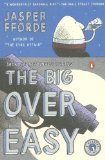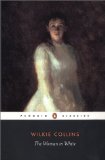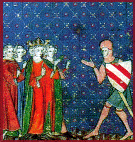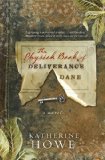 Jasper Fforde’s The Big Over Easy, the first in his Nursery Crime series, is a hilarious send-up not only of familiar nursery rhymes but also detective and thriller fiction. I am not sure the book would be to everyone’s taste. Fforde’s sense of humor runs toward the silly and punny, especially in this book. Detective Inspector Jack Spratt and his new partner, Detective Sergeant Mary Mary investigate the death of Humpty Dumpty and quickly find themselves embroiled in the “seedy underbelly of nursery crime.” Just as he did in his Thursday Next series, Fforde shows a thorough knowledge and clever use of literary allusion. I’ve heard Fforde’s books described as beach books for book nerds, and they are.
Jasper Fforde’s The Big Over Easy, the first in his Nursery Crime series, is a hilarious send-up not only of familiar nursery rhymes but also detective and thriller fiction. I am not sure the book would be to everyone’s taste. Fforde’s sense of humor runs toward the silly and punny, especially in this book. Detective Inspector Jack Spratt and his new partner, Detective Sergeant Mary Mary investigate the death of Humpty Dumpty and quickly find themselves embroiled in the “seedy underbelly of nursery crime.” Just as he did in his Thursday Next series, Fforde shows a thorough knowledge and clever use of literary allusion. I’ve heard Fforde’s books described as beach books for book nerds, and they are.
Fforde’s characterization of the murdered egg leaps from the pages, even though he has passed on by the time we meet him. We also meet other nursery favorites such as Old Mother Hubbard, Solomon Grundy, “Giorgio Porgia” (crime boss!), and Wee Willie Winkie. DI Spratt’s Nursery Crime Division is in trouble, and his boss is putting pressure on him to crack this case. Meanwhile, a former rival, Detective Chief Inspector Friedland Chymes, is trying to horn in on Spratt’s investigation and steal the case. Mary Mary isn’t so sure she wants to work with Spratt and his small, rag-tag staff. By the end of the novel, twist after twist follows as Spratt must use all his detective skills to unravel what really happened.
Fans of the Thursday Next series will recognize Mary Mary as the character that Thursday Next took over as part of the character exchange program. While we don’t go to Caversham Heights, we do hear a little bit from Arnold, Mary’s overenthusiastic admirer. Mary does have a little bit of the ring of Thursday Next about her.
I really enjoyed this book and would recommend it to anyone who like Fforde’s other books or likes a good laugh over a silly joke.





